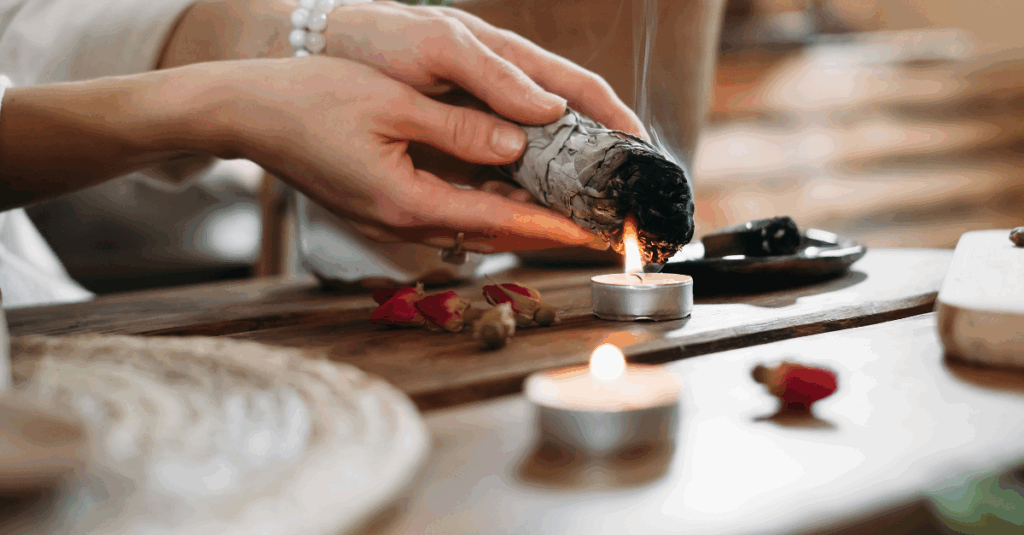
“Your home should be the story of who you are, and a collection of what you love.” – Nate Berkus
Our environments are like quiet, constant companions — shaping our moods, our thoughts, and even the way our bodies hold stress. Think of the last time you walked into a space that felt instantly calming: maybe it was the scent of cedar in the air, a beam of sunlight dancing across the floor, or the way everything felt just right. That magical feeling? Well, that’s environmental wellness at work.
When your surroundings feel aligned with your energy, your nervous system softens, your mind clears, and your spirit gets room to breathe. The beauty is, you don’t need a complete home makeover to create that feeling. Sometimes, it’s as simple as placing a plant where you’ll see it first thing in the morning, lighting a candle as the sun sets, or clearing one small corner where peace can gather.
In this post, we’re going to explore how the spaces around us influence our emotional and mental health, how to clear both physical and energetic clutter, and how to craft little pockets of sanctuary in your home. By the end, you’ll be ready to create a sacred space that not only looks beautiful, but truly feels like home for your soul.
How Clutter and Chaos Impact the Nervous System
Science has finally caught up with what our bodies have been whispering for years: clutter equals stress. Research from the Princeton University Neuroscience Institute shows that physical clutter competes for your brain’s attention, forcing your mind to process more visual stimuli than it can comfortably handle. This constant overstimulation drains mental energy, making it harder to focus, be creative, or simply relax.
But the effects aren’t just in your head — they’re in your body. When your environment feels chaotic, your nervous system can slip into a low-grade “fight-or-flight” state. Heart rate and cortisol levels creep up. Muscles stay slightly tense, ready for action. Your breath becomes shallow without you noticing. It’s the body’s ancient survival mechanism, triggered not by a tiger in the grass, but by that teetering stack of papers on the dining table or the overflowing laundry basket in the corner.
Clutter also creates what psychologists call “decision fatigue.” Every item out of place — the shoes in the hallway, the tangle of cords by your desk, the dishes in the sink — is another tiny decision your brain has to make: Should I deal with this now? Later? At all? Those micro-decisions add up, leaving you mentally tired before you’ve even started your real to-do list.
Think about it: how does your body feel when you walk into a messy kitchen after a long day? Shoulders inch up. Jaw tightens. There’s a subtle pressure in your chest, as if you’re already behind. Now imagine walking into a room that smells faintly of vanilla, where warm light pools in soft corners, and surfaces are clear except for a few intentionally placed objects you love. Your shoulders drop. Your breath deepens. That shift isn’t just aesthetic — it’s physiological. Your body finally gets permission to rest.
How to Energetically Cleanse Your Space
Just like dust and cobwebs can quietly build up in your home, stagnant or heavy energy can settle into a room over time. You might notice it as a subtle heaviness when you walk in — a feeling that’s “off” even if everything looks perfectly clean. This isn’t just poetic thinking; our environments can absorb and hold emotional imprints. Arguments, stress, or even long stretches of inactivity can leave behind an invisible residue that lingers.
Think of your home’s energy like water. When it’s flowing — like a fresh, clear stream — it’s vibrant, refreshing, and full of life. But when it becomes still and stagnant, like water trapped in a forgotten bucket, it can start to feel heavy, murky, and uninviting. Energetic cleansing is the practice of setting that water back into motion — letting light and movement restore it to its natural clarity.
Many cultures have their own traditions for this, and you can choose the ones that resonate with you most:
- Sage or Palo Santo: Used for centuries in Indigenous and South American traditions, these sacred plants are burned to purify and refresh a space. Light the bundle or stick, let the smoke curl upward, and slowly move through your rooms. Pay attention to corners, doorways, and windows — the places where energy likes to “pool.”
- Incense: Beyond its beautiful scent, incense can help set the tone for the energy you want to invite in. Sandalwood is grounding, rose is heart-opening, frankincense is deeply spiritual, and citrus scents brighten and uplift.
- Sound: Sound frequencies can break up dense energy and restore harmony. Try a crystal singing bowl, Tibetan bell, chimes, or even a playlist of gentle instrumental music. Let the vibrations ripple through your space like waves in water.
- Fresh Air and Sunlight: The simplest cleanse of all — open the windows, pull back the curtains, and let nature do her work. Fresh air disperses stale energy, while sunlight infuses a room with warmth and vitality.
Think of this process as a spiritual reset button for your space. You’re not just clearing out dust and debris — you’re restoring flow, like turning a stagnant pond into a sparkling stream once again.
Creating Ritual Corners
You don’t need an entire meditation room to create a sacred space — sometimes the most transformative sanctuaries are carved from the smallest corners. It’s less about square footage and more about intention. When you dedicate even a tiny area of your home to stillness, beauty, and ritual, it becomes a safe place your spirit naturally gravitates toward.
Think of it like tending a small patch of fertile soil in a wild garden. Even if the rest of the space is still a work in progress, that one cultivated area can become a source of nourishment and inspiration for everything around it.
Here are a few ways to plant that sacred seed in your home:
- Meditation Nook: Choose a spot near a window or in a softly lit corner. Lay down a cushion or folded blanket, drape a soft throw for warmth, and light your favorite candle. Over time, the moment you sit there, your body will remember: this is where we breathe deeply.
- Altar: Create a small surface that holds objects with personal meaning — a crystal that catches the morning light, fresh flowers, a photograph of someone you love, or a spiritual tool that grounds you. This is your personal anchor, a visual reminder of what matters most.
- Plant Sanctuary: Gather a cluster of plants in one area to create a living, breathing reminder of growth and renewal. Tending to them can become part of your ritual, grounding you in the steady rhythm of nature.
Your ritual corner should be a place you want to visit — somewhere that feels like a loving exhale every time you arrive. Over time, it becomes more than just a space in your home; it becomes a space within yourself that you can return to, again and again.
In Closing
Your home isn’t just the place where you sleep, eat, and store your things — it’s the energetic container for your life. When you clear the clutter, refresh the energy, and create intentional spaces that nourish you, you’re telling your mind, body, and spirit: You belong here. You are safe here.
This week, choose one small area of your home to transform into a sacred space. Maybe it’s clearing the kitchen counter so you can start your mornings with ease, setting up a tiny altar on your bedside table, or creating a plant-filled corner that greets you with life each time you pass by. Start small. Let the space evolve as you do. And notice — really notice — how your mood, focus, and overall sense of peace begin to shift.
We’d love to see your creations. Share a photo of your sacred space on social media and tag us so we can celebrate your sanctuary with you.
Note: All practices mentioned here are rooted in tradition and personal well-being, but they are not intended to diagnose, treat, or cure any condition. Always follow your own intuition and seek professional guidance where needed.

